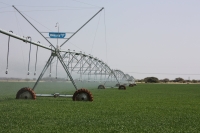Thursday, April 18, 2024
News and Views from the Global South
AGRICULTURE: Can South Africa Afford to Export Virtual Water?
Patrick Burnett
- Near the banks of the Orange River, farm manager Le Roux Viljoen sends off an SMS to a weather station and receives an almost instantaneous response telling him the temperature, wind direction and estimated evaporation index.

The wisdom of exporting water-intensive crops from water-scarce regions is under consideration. Credit: Patrick Burnett/IPS
In two months time, harvest will begin and the table grapes will fetch top prices as they arrive in European markets during the northern hemisphere winter.
The Kakamas area in South Africa’s Northern Cape province where the grapes are grown, however, receives minimal rainfall and farmers depend on water drawn from the Orange River, which receives water from the Lesotho highlands.
On either side of the irrigated vineyards, the land is brown and dry, populated by low scrubs.
Even though the lower reaches of the Orange River, from where the Vaal River meets the Orange to its mouth in Alexander Bay, are semi-arid, water-intensive crops such as grapes, pistachios, citrus, pecans and vegetables are grown in a green strip irrigated by the river.
On the other side of the river, in Namibia, similar vineyards can be found around Assenkehr. These are also irrigated from water pumped out of the river.
In the lower sections of the river, commercial agricultural accounts for 94 percent of the current total water requirement, according to figures from South Africa’s water affairs department. Irrigation is the biggest user of water in the Orange-Senqu river basin and with increased pressure on the resource, water extracted for this purpose is likely to come under increased focus.
Farmers around Kakamas are charged for water based on a quota system, which allocates a certain amount of water per hectare to each farmer.
This places the onus on the farmer not to exceed their quota and insiders acknowledge that the system is open to abuse.
Speaking off the record, one water official said it is inevitable that the system would eventually have to move to a metered system as this would more effectively control the amount of water being used and what was charged for it.
Moving from the current system to a metered one is a highly emotive issue amongst farmers, however, and installing and monitoring metering will be difficult.
But in a water-scarce system, does the growth of water-intensive crops for export even make sense?
With plans in place for construction of further phases of the Lesotho Highlands Water Project, which transfers water to South Africa, the World Wide Fund for Nature warned in an August report of the danger of water transfer schemes, arguing that they cause a "disproportioned amount of damage to freshwater ecosystems" and "unacceptable social and economic impacts both in the donor and the recipient basin".
The report said that in many cases there has been little examination of alternatives to these schemes, such as managing demand and promoting efficient water use.
Virtual water
The concept of virtual water attempts to assess trade in terms of the amount of water used in producing a commodity. Viewed through this lens, the farmers along the Orange River are exporting vast amounts of water out of a system that can ill-afford this.
Delegates on an Orange Senqu River Commission (ORASECOM) field trip in September were told by the Commission's technical task team member Peter Pyke that as water scarcity increases, so the most value possible has to be obtained from existing water supplies.
The idea is that instead of exporting virtual water out of the region ("embedded" in the boxes of juicy grapes from Viljoen's farm), water scarce regions should instead be importing crops from water-rich areas, saving water for other uses within the region.
"Much of the water saved locally could be reallocated to other uses and to environmental flows," says an awareness kit produced for ORASECOM, but adds that this would have to be balanced against the negative economic effects throughout the agricultural sector in South Africa.
ORASECOM executive secretary Lenka Thamae said the point is not to shrink the agriculture sector, which is a large employer of unskilled labour in the region, but to look at which crops are most suited for certain regions.
In the context of the Orange River, applying the concept of virtual water would imply that once an economic analysis of land and water had been done, farmers could be encouraged to adopt crops suitable to the areas they were farming in.
"Within the framework of regional co-operation like the SADC, areas with water and rainfall such as the Zambezi and parts of Angola could be encouraged to produce more crops," Thamae said.
The question of where to allocate any water saved by such changes is one that also needs to be addressed.
"Once you conserve water in one area, does industry qualify for additional water or does it become part of a bigger pot that can be used across countries?" asked Thamae. Mediating between conflicting demands from other countries in the Orange-Senqu basin and South Africa's mining and industrial users could be tricky.
But before that, said Thamae, it would be necessary to overcome the strong desire of individual countries to be self-sufficient in food to minimise the risk of relying on supply from beyond their borders.
The concept of virtual water is fast gaining ground as a way of understanding water use and management. But applying it to make concrete changes to trade patterns in the region is unlikely to take off soon.
In addition to the political questions and the potential for economic dislocation, Southern Africa's agriculture sector is poorly developed, and the water-rich countries that might be expected to become food exporters to drier regions are themselves reliant on food imports, says the ORASECOM awareness kit.
*This article is the third in a special series on the Orange-Senqu River.

 Print
Print



